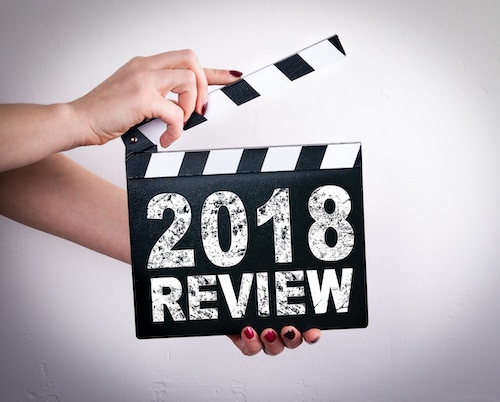 It is again time to take a moment to look back on the year that was, reflecting on the biggest, most impactful moments of 2017. For us that means looking backward and assessing the biggest moments and key events in the world of intellectual property.
It is again time to take a moment to look back on the year that was, reflecting on the biggest, most impactful moments of 2017. For us that means looking backward and assessing the biggest moments and key events in the world of intellectual property.
Each year I look back on my own writings and publish the top 10 patent stories for 2018, which this year featured new PTO Director unafraid to say it like it really is, an active Supreme Court, and reforms to the Patent Trial and Appeal Board.
Each year I also ask a panel of industry experts for their insights for our Biggest Moments in IP series, which is the longest running series on IPWatchdog.com. This year you will see there is near unanimity that the Supreme Court’s decisions in Oil States Energy v. Greene’s Energy Group, 138 S.Ct. 1365 (2018) was among the most significant events of the year. Several also point to the Federal Circuit’s decisions in Berkheimer v. HP Inc., 881 F.3d 1360 (Fed. Cir. 2018) and Aatrix Software v. Green Shades Software, 882 F.3d 1121 (Fed. Cir. 2018), the impact Director Iancu has had on the USPTO and the patent system, and Congress passing the The Music Modernization Act. Beyond those events, there were others identified by this diverse panel that might have gone unnoticed if we were to focus only on the top-line events of the year.
Without further ado, here is what our panel identified as the biggest moments in IP for 2018.
 Roberta Romano-Götsch
Roberta Romano-Götsch
Chief Operating Officer
European Patent Office (EPO)
In July 2018, António Campinos took over as President of the European Patent Office. Since then the Office has been gearing up to be even more user-oriented, to ensure that the patent system in Europe remains efficient and also effective for innovators. We have thus put a strong focus on gathering feedback from industry and other stakeholders. The President is also making the Office’s digital transformation a top priority, as using the latest technologies can help us to boost effectiveness.
2018 also saw continued growth in demand for patents in Europe: when we publish our annual results in a few months’ time, we’ll see that US companies continue to be the most active filers of patent applications at the EPO. Reaching out to US applicants in local seminars and workshops this past year has been of paramount importance in keeping them up to speed with the latest developments in our practice.
The EPO has paid particularly close attention to the rapid increase in inventions related to smart connected objects and other emerging technologies such as blockchain – a trend that can be observed across the full range of technical fields. In December 2017 already we had published a first study of the patent landscape in what we broadly termed “technologies of the Fourth Industrial Revolution”. In 2018, we followed up on this with two large technology-focused conferences, one on the patenting of artificial intelligence, and the other looking at the emergence of blockchain. A very recent study examined patents and self-driving vehicles:it found that patent applications related to automated driving have grown 20 times faster than in other technologies in recent years. The studies highlight that the EPO’s practice in examining computer-implemented inventions provides a stable and predictable approach, which strongly benefits inventors seeking patent protection in this field.
Roberta Romano-Götsch is the Chief Operating Officer of Mobility and Mechatronics at the European Patent Office (EPO). As Chief Operating Officer of one of the three technical areas at the EPO, Ms. Romano-Götsch has responsibility for leading 1,600 patent examiners, managers and administrative staff members in Munich and The Hague. In addition to leading Mobility and Mechatronics, she is also chair of the EPO’s Operational Quality Committee.
 Bob Stoll
Bob Stoll
Partner, Drinker Biddle
There were some significant moments in the IP world in 2018. While I don’t think any of them reach the levels of enactment of the America Invents Act (AIA) or the Supreme Court’s decision in Alice Corp v. CLS Bank (Alice), this year’s moments will have long term effects.
One of the most important events of the year was the twin decisions handed down by the Supreme Court on April 24, 2018.
In a totally unsurprising holding, the Supreme Court found by 7-2 in Oil States Energy Services v. Greene’s Energy Group that IPR does not violate the Constitution and the IPR is a permissible review on the patents. Justice Thomas, writing for the majority, stated that IPR is simply a reconsideration of the patent grant and Congress was acting within its authority to authorize the USPTO to conduct that reconsideration at the Patent Trial and Appeal Board (PTAB).
It’s a practical and expected outcome because to rule otherwise would wreak havoc on the US patent system with the possible resurrection of zombie patents that were already invalidated. Reversing would also have raised parallel questions about other non-article III courts that arguably take property and further unsettle the judicial ecosystem. However, the logic employed by the majority does seem a bit tortured in the discussion of a public right and that IPR is merely a permissible reconsideration of the original grant.
In the more interesting decision of the day, the Supreme Court held for SAS in SAS Institute v. Iancu by a 5-4 decision. The Court held that the PTAB can’t just review those claims that it maintains meet the threshold for institution. If instituting on any claim, the PTAB must handle all of the challenged claims on all of the challenged grounds. While partial institution is not discussed in the statute, at least the minority asserted that if the PTAB didn’t think that some of the challenged claims had a “reasonable likelihood of success” not instituting the process with respect to those claims was simply preventing a waste of time.
Another very important event this year was the decision in Berkheimer v. HP Inc. where the Federal Circuit determined that in step 2 of the Alice analysis of patent subject matter eligibility whether a claim element is routine, well-understood or conventional can be a question of fact. In circumstances where it is, summary judgement is improper. This is important as it makes the patent more difficult to challenge and requires petitioner to put forth facts showing that the claims are not patent eligible.
The action this year was not limited to patents. On October 11, 2018, The Music Modernization Act was passed into law. It updated music licensing to better facilitate legal licensing by digital services and provided federal protection for pre-1972 sound recordings. It was a true feat to get this through the divided Congress during a mid-term election cycle.
My final selection for IP moment of the year is not a single moment but a series of them. Recognizing the difficulty in enacting patent legislation or getting bright line tests on patent matters from the courts, Director Iancu has exercised his rule-making authority to issue several rules and guidelines to clarify court decisions and rationalize procedures before the Office. The Director is to be lauded for his iterative improvements in the handling of patent subject matter eligibility and post grant procedures. His use of rule-making changes may be the best way to improve the system in the short-term and I would urge him to continue his rule-making in 2019.
Robert L. Stoll has more than 40 years of experience in intellectual property prosecution. Bob retired from the USPTO as Commissioner for Patents at the end of 2011 after a distinguished 34-year government career. Bob serves as an expert on patent matters, and is known as a problem solver for cases with peculiar issues and problems. He is now Co-Chair of the Drinker Biddle Intellectual Property Group, and a member of the Patent Masters Faculty.
 Stephen Kunin
Stephen Kunin
Partner, Maier & Maier
In my opinion the two biggest moments of 2018 are focused on certain key activities of the USPTO. The first focus area is the dramatic positive impacts of Director Iancu’s initiatives on enhancing PTAB AIA trial practice and patent examination policy in the area of patent subject matter eligibility. The Claim Construction Final Rules, Motion to Amend Practice, Assignments of Judges to Panels, Formation of Precedential Opinion Panels and the Trial Practice Guide Update were all welcome additions to address systemic challenges presented by PTAB AIA trials. The policy enhancement in handling patent subject matter eligibility by limiting the scope of excluded subject matter based on abstract ideas to those categories specifically identified in Supreme Court precedent will provide a more fair and balanced approach to examination of claims under the two step Alice test. This is an area of patent law that has been problematic and in need of greater clarification. While the Federal Circuit has made great strides in 2018 in giving clarity to the contours of patent subject matter eligibility, it has yet to define the exact boundaries of abstract ideas. Director Iancu’s policy directive will help fill the gap. The second biggest moment was the shocking failure in the USPTO’s legacy patent IT systems that left both the USPTO and public users of the IT unable to efile patent applications and use Private PAIR. This multi-day disruption in IT service shed light on the urgent need to modernize and enhance the USPTO IT systems that have been underfunded for decades.
Stephen Kunin is currently a partner with Maier & Maier. He serves as an expert witness and consultant on patent policy, practice and procedure. He is also widely regarded as an expert on post grant proceedings at the Patent Trial and Appeal Board (PTAB). Mr. Kunin served three decades at the USPTO, including 10 years as Deputy Commissioner for Patent Examination Policy. Mr. Kunin is also a member of the Patent Masters faculty.
 Sherry Knowles
Sherry Knowles
Principle, Knowles IP Strategies
We started 2018 with news that the U.S. Chamber International IP Index (“GIPC” Feb 2018) ranked the United States only 13thin the category of “Patents, Related Rights and Limitations”, behind Singapore, a number of European countries, Japan and South Korea. Ouch. This was attributed to the decline in patent subject matter eligibility and the procedural and evidentiary framework of PTAB. GIPC even made the statement that “American leadership has become much less pronounced” in the area of patents.
Almost simultaneously in February, Andrei Iancu took the oath as the next Under Secretary of Commerce and Director of the PTO. As one of the lead counsel for Ariosa in the disturbing patent eligibility case of Ariosa v. Sequenom, in which Ariosa prevailed on the argument that a transformational blood prick test for genetic problems in babies given to mothers during pregnancy is not patent eligible, the future looked all the more bleak to many biopharmaceutical patent attorneys.
Director Iancu proved us wrong. In just one year in office, he is taking his place among the great PTO leaders. He is visionary, inspirational and has already taken steps to address U.S.’s disappointing report card in both columns. Director Iancu has established he will use all of the tools at his disposal to right the ship. This includes (i) his April Berkheimer Memo instructing Examiners that Step 2 of the court-made Alice/Mayo (rejecting claims with limitations that represent well-understood, conventional activity) can only be based on facts that are “widely prevalent or in common use in the industry”; (ii) the Notice of Proposed Rulemaking in May to change the PTAB claim construction standard to the federal court Phillipsstandard; and (iii) his June VandaMemo instructing Examiners to accept method of treatment claims that include a diagnostic claim as patent eligible. Most important is his general drive to repair the system that made America the world’s greatest innovator.
In 2018, we saw the CAFC try to put band aids on the judicial mess of patent eligibility in several decisions, including Berkheimer v. HP, Aatrix v. Greenshadesand Vanda v. Westward. There are also discussions and draft legislation brewing by stakeholders in Congress to fix the patent eligibility issues by statutory amendment. I will have more to say about that in the coming weeks, including a law review article to be released shortly.
Outside the U.S., there were a number of events relevant to the biopharma industry. The USMCA will extend data protection for biologics in Mexico and Canada to 10 years. We see the continued violation by developing countries (e.g., India and South American countries, among others) of the WTO TRIPS Agreement that requires countries to make patents available for any invention, whether product or process in all fields of technology without regard to discrimination (Art. 27.1).
In November, the U.K Supreme Court issued an opinion tightening the evidence necessary in a specification to establish a new use of a known compound, saying, while experimental data may not be the only acceptable evidence, a bare assertion of therapeutic efficacy is not enough, and the evidence must fit the specific scope of the claim. The Court said it was motivated by a need to prevent speculative patenting ([2018] UKSC 56), presenting a higher bar than in the U.S. This follows from the alarming 2017 decision from the EPO Board of Appeal holding patent claims on a commercial anti-cancer drug invalid on the basis that limited data in the specification was insufficient to render it plausible that the claimed commercial compound could be effective (T 0488/16 Dasatinib/Bristol-Myers Squibb).
Sherry Knowlesis Managing Partner with Knowles IP Strategy. From 2006-2010, Ms. Knowles was the Senior Vice President and Chief Patent Counsel at GlaxoSmithKline, where she served as the worldwide head of patents for all litigation and transactional matters and managed a global department of over 200 people in 12 offices. In 2008, Managing IP Magazine named Ms. Knowles one of the top 10 most influential people in Intellectual Property. In November 2011, Intellectual Asset Management Magazine listed her among the top 50 key individuals, companies and institutions that have shaped the IP marketplace in the last eight years. She has also been recognized by IAM Magazine as one of the top IP strategists in the world numerous times. Ms. Knowles is also a member of the Patent Masters faculty.
 Tracy-Gene G. Durkin
Tracy-Gene G. Durkin
Director, Sterne Kessler
2018 finally saw the end of the epic battle between Apple and Samsung over smart phone designs when the parties settled the case in May. At the center of the 7-year dispute were three iPhone design patents, which a California jury found in 2012 were infringed by Samsung. Throughout the history of the case, and particularly after the Supreme Court remanded for reconsideration of whether the original damage award of $399M was too high, many began to wonder if design patents had lost their luster, or at least their “teeth”. The answer was a resounding “no” when, after many twists and turns, Apple was finally awarded $539M in damages for Samsung’s design patent infringement.
One unique aspect of design patent infringement is that the patent owner can be awarded the infringer’s total profit from the infringement, an option Apple pursued. Clearly, the retrial of the Apple-Samsung case suggests that design patents will continue to be a significant deterrent to would-be copiers who risk disgorgement of their total profit from the sale of products incorporating patented designs. Based on this, I predict that design patents will continue to be an important part of the IP portfolios of sophisticated companies in 2019 and for many years to come.
Tracy-Gene G. Durkin is the practice leader of Sterne Kessler’s Mechanical & Design Practice Group and a member of the Trademark & Brand Protection Practice. Tracy is widely recognized as one of the country’s top design patent experts. Indeed, in 2017 Intellectual Asset Management noted that Tracy “needs no introduction as the country’s top design expert.”
 Josh Malone
Josh Malone
Inventor, Bunch-0-Balloons
I concur with other observers that 2018 saw tremendous improvements at the management and procedures at the USPTO-PTAB. However, that dramatic swing serves to illustrate the radical instability in our modern patent system. Every election or agency appointment alters the status of the rights to your invention. The timing of recent PTAB improvements appear to be working for me individually, but most inventors fare poorly over the long run. When the Supreme Court endorsed the politicization of patents in the Oil States decision, they ensured that 2018 would go down as one of the worst years in the history of the U.S. patent system (competing with 2006 and eBay). From 1790 to 2018 anyone could obtain property in America and move up the socio-economic ladder by disclosing their invention in exchange for a patent. Historian Zorina Kahn describes our former patent system as democratization of invention, where wealth and privilege were given no advantage over ingenuity. In contrast, the European system granted patents for a fee or as a favor of the King. In April of 2018 the Supreme Court of the United States threw out our historic system with a 7-2 ruling that patents are no longer property rights, but are public franchises like the right to operate a toll bridge. Now we back to where we were in England in the 1700’s – if you are wealthy and have friends in the government you can have a patent. This has accurately reflected the experience of inventors in the current patent system. This year United States patents were demoted – once property like land, now a government favor like food stamps. The Supreme Court’s Oil States decision stripping inventors their patent rights without an Article III judge and jury made 2018 a very terrible year for patents.
Josh Malone is Founder and President of Tinnus Enterprises, and a Fellow with U.S. Inventor. He is best known as the inventor of Bunch-o-Balloons, a device and method for filling up 100 water balloons in 60 seconds. His invention was knocked-off by Telebrands, and after years of litigation in federal courts and at the PTAB his patents have survived, but only after tens of millions in legal fees. Josh is now a vocal advocate for patent reforms that aid independent inventors.
 Marla Grossman
Marla Grossman
Partner, American Continental Group
In May 2018, Intellectual Property Owners Association (IPO) and the American Intellectual Property Law Association (AIPLA) – two of the largest IP bar associations – adopted a joint legislative proposal to address concerns regarding current patent subject matter eligibility jurisprudence. Since that time, several other IP and patent bar associations have lent their support for the joint proposal, including the New York Intellectual Property Law Association (NYIPLA), the Boston Patent Law Association (BPLA), the Philadelphia IP Law Association (PIPLA) and the National Association of Patent Practitioners (NAPP). Agreement by these patent and IP bar associations on a single legislative proposal on patent subject matter eligibility was a significant step toward addressing this important policy matter.
Director Iancu’s announcement at the September 2018 IPO Annual Meeting that the PTO is working on revised patent eligibility guidelines designed to keep patent eligibility issues and conditions-for-patentability issues “in their own distinct lanes.” Director Iancu noted that the PTO has “thousands of examiners who struggle with these issues on a daily basis. Our examiners need additional guidance now. And so do patent applicants, patent owners, and the public. Whether through legislation or otherwise, there is a growing consensus that the issue must be promptly addressed.” Thus, the PTO is contemplating revised guidance to help categorize the exceptions to subject matter eligibility, to name them, and to instruct examiners on how to apply them. According to Director Iancu, the contemplated guidance would do two primary things: First, it would categorize the exceptions based on a synthesis of the case law to date. And second, if a claim does recite a categorized exception, it would instruct examiners to decide if it is “directed to” that exception by determining whether such exception is integrated into a practical application. These two welcome clarifications by the PTO are intended to instill greater predictability into the relevant analysis while remaining true to the case law that gave rise to these judicial exceptions in the first place.
The roundtable discussion hosted earlier this month by Senator Tillis and Senator Coons on patent subject matter. The roundtable addressed the status of the case law on 35 U.S.C. § 101, the need for legislative reform, and the merits of different legislative approaches. This event signaled congressional realization that despite the positive steps by PTO Director Iancu to revise patent eligibility guideline, congressional action is still necessary.
Director Iancu’s speech at the Eastern District of Texas Bar Association Inaugural Texas Dinner on October 18, 2018. The PTO director courageously used his bully pulpit to urge policies that encourage inventors and entrepreneurs, focus on the benefits of the patent system, and do not over-emphasize the risks to the system. He explained that in certain stakeholders’ efforts to eliminate so-called “trolls,” (a term that still defies a commonly agreed-on definition), we have over-corrected. Director Iancu clearly and cogently argued against the false narrative that patents hinder innovation, and urged a restoration of balance in our patent system.
The PTO’s final rule published Oct. 11, 2018 that would replace the current broadest reasonable interpretation (BRI) claim construction standard for interpreting claims in inter partes review, post grant review, and covered business method patent proceedings with the Phillips standard, which is applied in federal courts and the U.S International Trade Commission (ITC). This rule appropriately responds to concerns that current PTAB procedures and the application of BRI standards were unfairly biased against patent owners. Specifically, the new rule would require the PTAB to construe unexpired and proposed claims “in accordance with the ordinary and customary meaning of such claim as understood by one of ordinary skill in the art and the prosecution history pertaining to the patent.” The proposed rule would also require the PTAB to consider prior claim construction determinations made by federal courts or the ITC. The PTO’s proposed rule is consistent with the reasonable position that the PTO should construe claims according to the standard used “in a civil action to invalidate a patent under 35 U.S.C. § 282 and would significantly reduce uncertainty in this area of the law.
The Enterprise System failure at the PTO in August 2018. The system failure, which affected the PTO’s Electronic Filing System (EFS), the Public and Private Patent Application Retrieval (PAIR) systems and the Electronic Patent Assignment (ePAS) among others, adversely impacted filers, examiners, and the rest of the agency since significant resources had to be redirected internally to manage the problem. If there is a silver lining, it is that the outage reinforced the PTO’s recognition of the need to update and modernize its aging enterprise IT infrastructure. This is a task that will benefit from insights provided by external consultants and contractors who bring specialized analysis and recent modernization experience.
The enactment into law of the Music Modernization Act (MMA) in October 2018, after unanimous passage in both the House of Representatives and the Senate. Specifically, this legislation helps creators across the music industry to make a living through their creativity by: (1) improving compensation to songwriters and streamlining how their music is licensed; (2) enabling legacy artists (who recorded music before 1972) to be paid royalties when their music is played on digital radio; and (3) providing a consistent legal process to enable studio professionals—including record producers and engineers—to receive royalties for their contributions to music that they helped create. This legislation represents the most comprehensive reform of music law in over twenty years and demonstrates how IP stakeholders with very different business models and priorities can come together to support and pass complex IP legislation.
Marla Grossman is a partner at American Continental Group, where she helps her clients with strategic public policy planning and representation before the White House, US federal agencies, and Congress. Grossman’s particular areas of expertise include intellectual property, technology, competition and trade policy. With decades of experience inside the beltway, including as counsel to the Senate Judiciary Committee, Marla is a true powerhouse on the intellectual property scene.
 Stephen Key
Stephen Key
Co-Founder of InventRight, LLC
For me the biggest moment of 2018 was bringing together 30 leaders of inventing groups across America for the first time. As our conference got underway, the director of the United States Patent & Trademark Office stopped by to express his support for independent inventors and Inventors Groups of America, the new organization I cofounded with my business partner Andrew Krauss in 2017. That was incredible.
As leaders of our industry volunteered their expertise throughout the day, you could feel the energy in the room surging with positivity and excitement. On the second day of our conference, we met with our representatives on Capitol Hill to relate the importance of invention. For these leaders — who work selflessly and without recognition to support inventors in their communities — the impact was profound.
I personally want to thank the United Inventors Association, US inventor, Inventor’s Project, and Gene Quinn for helping make this dream become a reality.
I sincerely believe the inventing community is stronger when we band together.
Stephen Key is an inventor, author, speaker and co-founder of InventRight, LLC. Stephen is recognized as a leading expert in licensing consumer product ideas. Stephen was also selected by the American Association for the Advancement of Science as a Lemelson Invention Ambassador for 2018-2019. In 2017, Stephen co-founded Inventors Groups of America.
Image Source: Deposit Photos

![[IPWatchdog Logo]](https://ipwatchdog.com/wp-content/themes/IPWatchdog%20-%202023/assets/images/temp/logo-small@2x.png)

![[[Advertisement]]](https://ipwatchdog.com/wp-content/uploads/2024/04/Patent-Litigation-2024-banner-938x313-1.jpeg)
![[Advertisement]](https://ipwatchdog.com/wp-content/uploads/2024/04/UnitedLex-May-2-2024-sidebar-700x500-1.jpg)
![[Advertisement]](https://ipwatchdog.com/wp-content/uploads/2024/04/Patent-Litigation-Masters-2024-sidebar-700x500-1.jpg)

![[Advertisement]](https://ipwatchdog.com/wp-content/uploads/2021/12/WEBINAR-336-x-280-px.png)
![[Advertisement]](https://ipwatchdog.com/wp-content/uploads/2021/12/2021-Patent-Practice-on-Demand-recorded-Feb-2021-336-x-280.jpg)
![[Advertisement]](https://ipwatchdog.com/wp-content/uploads/2021/12/Ad-4-The-Invent-Patent-System™.png)






Join the Discussion
8 comments so far.
Night Writer
January 2, 2019 08:06 amA bit disturbing that Stoll is minimizing Oil States. Oil States was by far the biggest case in patent law this year and of the last century.
It ends patents as property. And the result was based on phony made-up data by Lemley published in non-peer reviewed article (UVA Law Journal) where there is no recourse for unethical conduct. The dissent even said that they did not agree with the Lemley fabricated data.
This was big. And Alito not joining the dissent was a big blow to patent law.
B
January 1, 2019 10:44 pm“Unfortunately, much like the thought experiment regarding the training of simians in a cage with a fire hose, the current members of the CAFC (with very very few exceptions – like maybe two members) have been browbeaten by the Supreme Court into a similar-minded anti-patent frenzy”
I respectfully disagree, but only to a small degree.
The SCOTUS has repeatedly insisted that the CAFC address the exceptions to 101 based on preemption and pay attention to the actual wording of 101. The Machine or Transformation test was idiotic, and at the time Alice Corp. was decided, the CAFC had three separate patent-eligibility test that were irreconcilable.
Now there are at least 36 irreconcilable tests, b/c the SCOTUS stepped on a rake by insisting on “invention,” where after the CAFC divorced the exceptions to 101 from preemption (Ariosa).
Thus, invention has replaced preemption as the concern for the preemptive effects of a claim. So bizarre that only a judge could believe it
Anon
January 1, 2019 05:01 pmNight Writer.
Unfortunately, much like the thought experiment regarding the training of simians in a cage with a fire hose, the current members of the CAFC (with very very few exceptions – like maybe two members) have been browbeaten by the Supreme Court into a similar-minded anti-patent frenzy.
Night Writer
January 1, 2019 11:06 amName withheld >>> “Anybody ever wonder why these companies are SITTING on huge amounts of cash? They have this cash, in part, because the current patent system (thanks to the likes of Mayer) make efficient infringement possible. ”
This is exactly right, although partly due to anti-trust laws too. But Jimmy Carter realized this too and set up the CAFC to end the great malaise.
Name withheld to protect the innocent
December 31, 2018 07:57 pmI just read In re: Marco Guldenaar Holding. I’m not fond of criticizing a particular judge, but J. Mayer is a disgrace to the Federal Circuit. He would deny patent protection to biggest driver of the US economy in the 21st century — which is the computer industry and the service industries that rely upon software. He probably yearns for the days (in the early 80s) when the patents he handled as a judge where mostly mechanical in nature and he could (somewhat) understand them.
The technology today has long past Mayer by yet he is still fighting to drag patent law back to the 20th century.
I have to wonder whether he realizes that his efforts to kill all patents involving computers does not help the little guy or the United States? Companies like Facebook, Apple, Google, and Microsoft are de facto monopolies in their respective fields. They have the money and the market power to subsume any new computer-implemented technology. Heaven help any inventor that comes up with “better mousetrap” that involves a computer. The world won’t beat a path to their door. Rather, you’ll have one of these mega-companies throw some of their hoarded cash to reverse engineer the technology (between Apple, Microsoft, and Google, they are sitting on over $500 billion with a “b” in cash) and there is no way an inventor can compete with the pre-existing client base enjoyed by these mega-companies. What does the inventor get? The answer is nothing. What is even worse is if the inventor received patent protection. If so, they could literally waste hundreds of thousands (if not more) in an attempt to protect their technology only to have the likes of Mayer destroy all of their hard work (and protection) with a swipe of the pen.
Anybody ever wonder why these companies are SITTING on huge amounts of cash? They have this cash, in part, because the current patent system (thanks to the likes of Mayer) make efficient infringement possible. Why pay/license for technology why you can outright steal it? These companies are built on appropriating other people’s technology without paying for it.
Imagine what our economy would be like if true entrepreneurs and innovators were actually getting a piece of that pie that has been accumulated by the mega-corporations? I am 100% sure that these entrepreneurs/innovators wouldn’t be SITTING on this cash like the mega-companies. Rather, they would be using their fair share to develop their own companies and new technology (mostly in the US) thereby spreading the wealth (and employment opportunities) within the United States.
As is well known, much of the cash being hoarded by these mega-companies are sitting offshore to avoid US taxation. How does that help the US economy?
If people think that the likes of Google, Microsoft, Facebook, and Apple have too much power, then you can thank the likes of Mayer. Mayer’s anti-software patent agenda has allowed these companies to accumulate mass amounts of money while insulating them from disrupting technologies.
It is an embarrassment that Mayer is still participating in cases at the Federal Circuit.
Anon
December 31, 2018 08:14 amTo the title of the article here then, perhaps the most important thing happening in patent law is the absolute cratering of the Rule of Law as is being seen with the attempted use of Common Law law writing from both the judicial branch (including especially the Supreme Court) and the executive branch as the application of the “I know it when I see it – two step” Common Law formula ricochets from decision to decision based on the PRE-determined feelings of the decision makers involved.
I recall noting after the disappointment of the SC Alice decision, that maybe the best thing to do was to stomp on the gas pedal with what the Court has (re)written, and crash the car as quickly (and as messily) as possible so that (similar to 1952), we shake Congress from their doldrums and have them properly reset the law that is their sole dominion.
Sadly, as much of a catastrophe as the current situation is (and given the unhealthy presence of the effects of Citizens United), I still do not think that Congress will take the now clearly necessary step of jurisdiction stripping and resetting a new lower Article III court.
In the meantime, as we all still await Iancu’s new direction on 101, I still “dream” that he forcefully constrains the Common Law law writing and refuses to partake in such for the entire Executive Branch (and calls out exactly what the judicial branch is doing).
B
December 31, 2018 12:52 am@ BP “Well said, band aids on the decisions in Berkheimer v. HP Inc. . . . . ”
Amazing that Mayer, who signed on to Berkheimer seven months ago, wants to repeal it now. The decision in Guldenaar was idiotic enough. Complete vacuous trash. However, Mayer’s concurrence is beyond stupid and ignorant to the point of being criminal. Mayer obviously got his law degree mail order from Nigeria, because he has no concept that what he proposes to justify calling something “abstract,” i.e., “general historical observations,” is naught but judicial notice, which is an issue of evidence under FRE 201 – not of law
No holding by the Federal Circuit likely survives the next Federal Circuit decision. The Federal Circuit are capricious children.
BP
December 30, 2018 08:08 pmWell said, band aids on the decisions in Berkheimer v. HP Inc., 881 F.3d 1360 (Fed. Cir. 2018) and Aatrix Software v. Green Shades Software, 882 F.3d 1121 (Fed. Cir. 2018). And now, in that vein, a concurrence by J. Mayer in In re: Marco Guldenaar Holding B.V., decided December 28, 2018:
“Because patent eligibility is a pure question of law, section 101 can, and should, be used to strike down patents at the earliest stages of litigation, or even before, as in this case from the PTO. Patent disputes are notoriously time-consuming and costly.”
J. Mayer further states that the patent system is to “promote[d] the Progress of Science and useful Arts” – understood to be by making sure nobody gets a patent, and if they do, it should be struck down as a matter of law. Wow!
Promoting the progress of science by killing patents and making everything trade secret so employers can screw their employees.
A strong patent system gives employers what they can use (IP) and frees inventors to do what they do best, invent. That’s not what J. Mayer wants. Talk about turning the Constitution on its head!